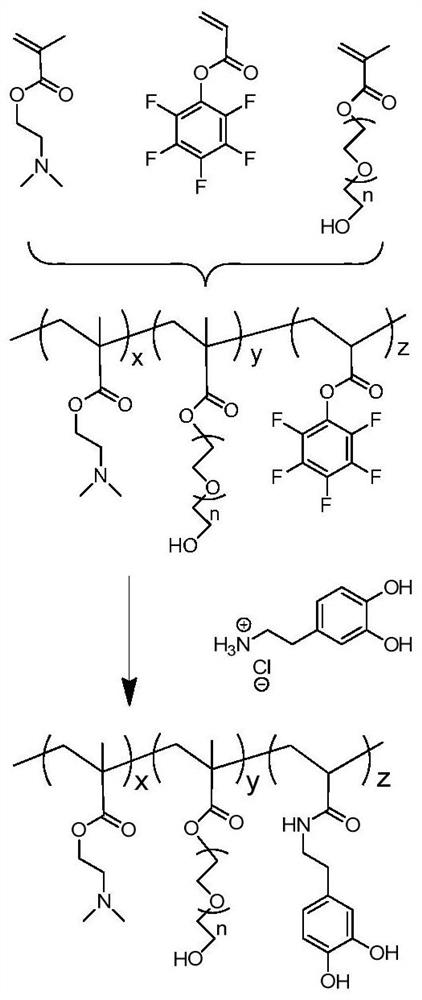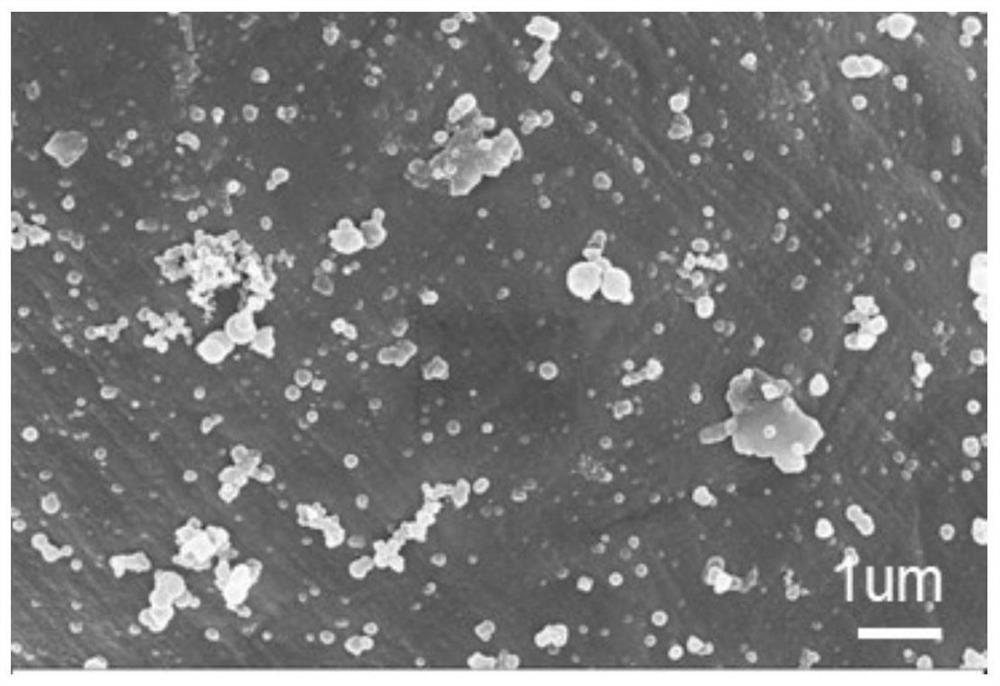A kind of oil-water separation omentum and its preparation method and application
A technology for oil-water separation omentum and oil-water separation, applied in separation methods, liquid separation, semi-permeable membrane separation, etc., can solve the problems of poor feasibility, high cost, cumbersome preparation process, etc., and achieve improved utilization efficiency, good hydrophilic Oily, anti-penetration effect
- Summary
- Abstract
- Description
- Claims
- Application Information
AI Technical Summary
Problems solved by technology
Method used
Image
Examples
Embodiment 1
[0043] A kind of preparation method of oil-water separation omentum, comprises the steps:
[0044] (1) Synthesis of copolymers containing polyethylene glycol hydrophilic chains, dimethylaminoethyl hydrophobic chains and mussel biomimetic catechol groups;
[0045] Synthetic route such as figure 1 As shown, in the first step, dimethylaminoethyl methacrylate (1.57g), poly(ethylene glycol) methacrylate (4.75g), pentafluorophenol acrylate (2.38g), RAFT reagent 2- (Dodecyltrithiocarbonate)-2-methylpropionic acid (0.40g) was dissolved in 30mL 1,4-dioxane, stirred for 20min under nitrogen gas; adding the initiator azobisisobutyronitrile (0.04g), stirred for 10 min under the protection of nitrogen to obtain the first reaction system; transferred the first reaction system to a 72 °C oil bath and stirred for 3-4 h to obtain the second reaction system; the second reaction system was spun at 60 °C After evaporation and concentration, it was slowly dropped into n-hexane, and the product I...
Embodiment 2
[0058] (1) Synthesis of copolymers containing polyethylene glycol hydrophilic chains, dimethylaminoethyl hydrophobic chains and mussel biomimetic catechol groups;
[0059] Synthetic route such as figure 1 As shown, in the first step, dimethylaminoethyl methacrylate (3.14g), poly(ethylene glycol) methacrylate (9.5g), pentafluorophenol acrylate (4.76g), RAFT reagent 2- (Dodecyltrithiocarbonate)-2-methylpropionic acid (0.20g) was dissolved in 60 mL of 1,4-dioxane, stirred for 20min under nitrogen protection; the initiator azobis Isobutyronitrile (0.02g), stirred with nitrogen gas for 10min to obtain the first reaction system; transferred the first reaction system to a 72°C oil bath and stirred for 3~4h to obtain the second reaction system; the second reaction system was spun at 60°C After evaporation and concentration, it was slowly dropped into n-hexane, and the product I was precipitated.
[0060] In the second step, dissolve the obtained product I in 60 mL of dichloromethane...
Embodiment 3
[0070] (1) Synthesis of copolymers containing polyethylene glycol hydrophilic chains, dimethylaminoethyl hydrophobic chains and mussel biomimetic catechol groups;
[0071]In the first step, dimethylaminoethyl methacrylate (2.36g), poly(ethylene glycol) methacrylate (7.13g), pentafluorophenol acrylate (3.57g), RAFT reagent 2-(12 Alkyl trithiocarbonate group)-2-methylpropionic acid (0.40) was dissolved in 45 mL 1,4-dioxane, stirred for 20 min under nitrogen protection; adding initiator azobisisobutyronitrile ( 0.04g), stirred with nitrogen for 10 min to obtain the first reaction system; transferred the first reaction system to a 72°C oil bath and stirred for 3-4 h to obtain the second reaction system; the second reaction system was concentrated by rotary evaporation at 60°C Afterwards, it was slowly dropped into n-hexane, and the product I was precipitated.
[0072] In the second step, dissolve the obtained product I in 45mL of dichloromethane, add dopamine hydrochloride (5.70g...
PUM
| Property | Measurement | Unit |
|---|---|---|
| concentration | aaaaa | aaaaa |
| separation | aaaaa | aaaaa |
| separation | aaaaa | aaaaa |
Abstract
Description
Claims
Application Information
 Login to View More
Login to View More - R&D
- Intellectual Property
- Life Sciences
- Materials
- Tech Scout
- Unparalleled Data Quality
- Higher Quality Content
- 60% Fewer Hallucinations
Browse by: Latest US Patents, China's latest patents, Technical Efficacy Thesaurus, Application Domain, Technology Topic, Popular Technical Reports.
© 2025 PatSnap. All rights reserved.Legal|Privacy policy|Modern Slavery Act Transparency Statement|Sitemap|About US| Contact US: help@patsnap.com



